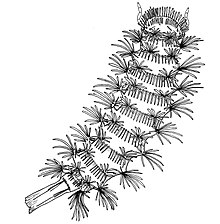| Lophoproctidae | |
|---|---|

| |
| Lophoproctus coecus | |
| Scientific classification | |
| Domain: | Eukaryota |
| Kingdom: | Animalia |
| Phylum: | Arthropoda |
| Subphylum: | Myriapoda |
| Class: | Diplopoda |
| Order: | Polyxenida |
| Family: | Lophoproctidae Silvestri, 1897 |
Lophoproctidae is a family of millipedes in the order Polyxenida containing approximately 65 species in 6 genera.
Description

Lophoproctids are distinguished by a soft body, bearing bristles at the posterior end of each diplosegment; they are blind and generally lack pigmentation. Individuals are small, ranging in size from 1.2 to 4.2 mm. Adults have 13 pairs of legs with internal leg buds, except for those in one species (Lophoturus madecassus), which have only 11 pairs of legs.
Genera
As of 2017, the family contains the following genera:
- Alloproctoides Marquet & Condé 1950
- Ancistroxenus Schubart 1947
- Lophoproctinus Silvestri 1948
- Lophoproctus Pocock 1894
- Lophoturus Brölemann 1931
- Plesioproctus Condé 1964
References
- ^ Sierwald, P. "Lophoproctidae Silvestri, 1897. In: Sierwald, P. MilliBase (2017)". MilliBase, 12th January 2017. Retrieved 4 October 2017.
- Bueno-Villegas, Julián; Rojas-Fernández, Patricia (1999). "Fauna de Milpiés (Arthropoda: Diplopoda) de una Selva Alta de los Tuxtlas, Ver. México". Acta Zoológica Mexicana. 76: 59–83.
- Enghoff, Henrik; Golovatch, Sergei; Short, Megan; Stoev, Pavel; Wesener, Thomas (1 January 2015). "Diplopoda — taxonomic overview". Treatise on Zoology - Anatomy, Taxonomy, Biology. The Myriapoda, Volume 2: 363–453. doi:10.1163/9789004188273_017.
- Melic, Antonio (2015). "Introducción a la Clase Diplopoda". Ibero Diversidad Entomológica @ccesible (Revista IDE@-SEA). 23: 1–18.
- Car, Catherine A.; Short, Megan; Huynh, Cuong; Harvey, Mark S. (2013). "The Millipedes of Barrow Island, Western Australia (Diplopoda)" (PDF). Records of the Western Australian Museum. 83: 209–219.
This myriapoda-related article is a stub. You can help Misplaced Pages by expanding it. |